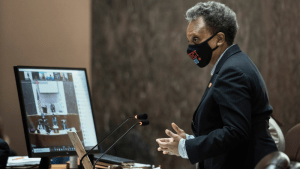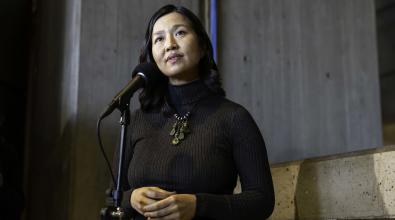City leaders adapt as remote engagement landscape keeps shifting

Chicago Mayor Lori Lightfoot speaks at a council meeting streamed online last year. During the pandemic, city leaders have had to continuously adapt hearings and other forms of resident engagement, often in ways that are bringing more community voices to the table than before. (Ashlee Rezin Garcia/AP)
For city leaders everywhere, from Chicago to Copenhagen to Cape Town, the early days of the COVID-19 pandemic made for a hectic experiment in how to engage residents remotely. In Baltimore, “the first two weeks were really fast and furious,” says Emily Ianacone, deputy director of the Mayor’s Office of Performance and Innovation. “Just winging it.”
They started by informally monitoring social media to see how people were talking about the virus and to track disinformation. Gradually, their strategy became more sophisticated, beginning with putting out basic public-health messaging on social media and billboards. But they knew they had to find deeper and more targeted ways to communicate with residents in an environment where the status quo was no longer an option.
That spring, Ianacone and her colleagues began holding focus groups with community leaders in Black neighborhoods of West Baltimore over Zoom. These virtual sessions became a forum for co-creation, with residents offering ideas on how to reach people who don’t interact with social media or city hall’s other traditional channels.
After sending draft designs back and forth with the group over text message, city leaders printed 20,000 cardboard fliers with information on how to slow the spread of COVID-19. Community leaders then helped to distribute the fliers around West Baltimore. Ianacone says working closely, if remotely, with the community in this way ensured that the messages resonated and reached people.
For local leaders, COVID is presenting fresh challenges and new opportunities for the practice of civic engagement. While traditional in-person council hearings and community meetings have taken a hit, cities are finding new ways to include residents, often at a deeper level or in ways that bring new community voices to the table. As cities grapple with the latest wave of Omicron-fueled disruptions, here are some of the lessons they’re learning about how to engage residents that are likely to stay relevant long after the pandemic ends.
Participation boom
On March 23, 2020, the day after New Mexico suffered its first COVID-related death, Albuquerque Mayor Tim Keller hosted a telephone town hall for residents. To anyone accustomed to typical, sparsely attended city council hearings, the interest level was off the charts. More than 20,000 people dialed in to hear what the Mayor had to say.
Since then, Albuquerque has continued hosting telephone town halls on all sorts of topics. While participation has waned since the early peak, says Staci Drangmeister, a marketing and innovation manager in the mayor’s office, doing this over telephone is proving a potent way to reach residents without internet access. Community feedback heard this way, such as residents’ concerns about speeding drivers, helped push forward the city’s ambitious new plan for traffic and pedestrian safety.
“What we hear in those town halls definitely informs what we do at city hall,” Drangmeister says. “It’s a way that we’re really attempting to turn city hall inside out.”
Similarly, the shift of many public meetings to Zoom and livestreaming on Facebook and other platforms has opened participation to entirely new groups of residents. City councils, school boards, and planning commissions are seeing people who never came to in-person meetings on weeknights, particularly parents, people who work late shifts, or those without easy transportation options. As Bloomberg recently reported, many cities are considering making the switch permanent or sticking with hybrid models.
In the summer of 2020, Meghann Lucy, a Ph.D. student in sociology at Boston University, was a fellow in the Boston Mayor’s Office of New Urban Mechanics. She spent the summer assessing the city’s public engagement activities amid the shift to remote work. Departments saw three-to-four times more attendees as before COVID, she later wrote, and a more diverse group of people participating. But even that boost, she noted, left too many voices unheard.
Going forward, Lucy recommends taking what she calls a “multimodality approach.” This entails both in-person and online meetings to reach as many people as possible, but could also involve seeking feedback from young people at a local high school, tapping social media, and enabling residents to participate asynchronously as well. She also recommends listing all upcoming virtual meetings on a single website so residents can find opportunities to weigh in.
“We can use this moment,” Lucy wrote, “to fundamentally change the way we do things and how we view and engage with each other.”
Going online to engage offline
Early in the pandemic, remote engagement often served as a stand-in for getting together in-person. Now, there’s opportunities to use online tools in ways that can actually deepen resident engagement offline.
That’s something Martha Fedorowicz wrote about in an Urban Institute guide called “Community Engagement During the COVID-19 Pandemic and Beyond.” When it’s done well, she writes, remote engagement can “create connections between strangers [and] build social capital and support networks.” Fedorowicz suggests building into online meeting agendas time for activities and small-group discussions — creating opportunities for neighbors who may not know each other to get acquainted.
Likewise, online platforms have become critical for mobilizing volunteers. In Albuquerque, the pandemic supercharged the city’s One Albuquerque platform for connecting residents with volunteer projects such as distributing personal protective equipment and vaccines. Now, on the volunteer platform, city departments and more than 350 organizations recruit from among thousands of volunteers for various projects. Nearly 5,000 volunteers signed up in 2021 alone, including many young people eager to help their neighbors.
The volunteer platform has “turned into a resource for community engagement,” says David Chené, the city’s civic engagement manager. One Albuquerque has begun organizing community block parties, with opportunities for partner organizations to offer resources to underserved residents. “The idea is not to just show up one Saturday and then disappear,” Chené says. “It’s that ongoing presence to keep youth engaged.”
Staying ready to pivot
If one thing’s become clear in the past two years, it’s that anything and everything in a pandemic can change—and fast. That’s also true with public attitudes toward engaging with government.
In Baltimore, Ianacone says that digital participation in community association meetings has “skyrocketed.” But it’s become much more difficult for city leaders to use an informal tactic they previously deployed to bounce ideas off residents or gut-check their assumptions.
Before the pandemic, Ianacone says, members of the Office of Performance and Innovation and other city departments would often leave the office and chat up people at high-traffic bus stops. That’s not so easy to do anymore. “Something that’s happened since the pandemic started is people don’t want to talk to you on the street anymore,” Ianacone says.
Developing successful engagement strategies requires being sensitive to what residents are comfortable with. More people from more communities may be interested in engaging online these days. The flipside of that, in the wake of the pandemic, could be a new and lasting reticence to participate in person. Local leaders need to be willing to leave certain strategies behind when they’re no longer working, Ianacone says.
“Gone are the days of my team dropping into a neighborhood," she says. "It changed things for the foreseeable future.”

